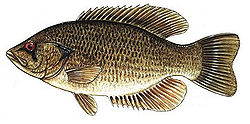Rock Bass
| Rock bass | |
|---|---|
 |
|
| Rock bass | |
| Scientific classification | |
| Kingdom: | Animalia |
| Phylum: | Chordata |
| Class: | Actinopterygii |
| Order: | Perciformes |
| Family: | Centrarchidae |
| Genus: | Ambloplites |
| Species: | A. rupestris |
| Binomial name | |
|
Ambloplites rupestris (Rafinesque, 1817) |
|
The rock bass (Ambloplites rupestris), also known as the rock perch, goggle-eye, red eye, is a fresh water fish native to east-central North America. This red eyed creature is a species of freshwater fish in the sunfish family (Centrarchidae) of order Perciformes and can be distinguished from other similar species by the six spines in the anal fin (other sunfish have only three anal fin spines).
Rock bass are native to the St Lawrence River and Great Lakes system, the upper and middle Mississippi River basin in North America from Québec to Saskatchewan in the north down to Missouri and Arkansas, south to the Savannah River, and throughout the eastern U.S. from New York through Kentucky and Tennessee to the northern portions of Alabama and Georgia and Florida in the south. The rock bass has also been found in the Nueces River system in Texas
They are similar in appearance to smallmouth bass, but are usually quite a bit smaller. Identifying characteristics of rock bass are their two dorsal fins that have spinous and soft-rayed united portions, a large mouth, six anal spines, red eyes; rows of dark dots on their sides. The mouth of a Rock bass is located in the terminal position, below the snout, with small conical teeth to eat prey. The average rock bass is between 6 and 10 in, and they rarely weigh over a pound. Few rock bass live beyond 10 to 12 years. A. rupestris, the largest and most common of the Ambloplites species, has reached a maximum recorded length of 43 cm (17 in), and a maximum recorded weight of 1.4 kg (3.0 lb). It can live as long as 10 years. These fish have body coloring from golden brown to olive with a white to silver colored belly and have the ability to rapidly change their color to match their surroundings. This chameleon-like trait allows them to thrive throughout their wide range.
...
Wikipedia

